I artiklen Did Earth Steal Martian Waters, (Stjal Jorden vand fra Mars) beskrev jeg hvordan en elektrisk udladning omkring 12.500 BP [BP betyder "before present" eller på dansk "før nu"] kan have overført en del af vandet på Mars' overflade og i dens atmosfære til Jorden (se den lyserøde pil i diagrammet nedenfor).
I artiklen med overskriften Of Flash-frozen Mammoths and Cosmic Catastrophes (Om lynfrosne mammutter og kosmiske katastrofer) forklarede jeg, hvordan der omkring 400 år tidligere, ca. 12.900 BP var adskillige kometfragmenter, der ramte Jordens nordlige halvkugle (se den turkisfarvede pil), som ledte til den efterfølgende globale nedkøling.
Imens jeg skrev disse artikler, blev det mere og mere klart, at disse kun var to af tre katastrofale hændelser, som gik forud for yngre dryas perioden. I diagrammet ovenfor kan vi se, at en tredje hændelse indtraf omkring 14.400 BP (se den grønne lodrette linje).
Denne begivenhed havde et endnu større omfang end de to efterfølgende, eftersom det fremkaldte et temperaturfald på10°C (graders Celsius), mens de efterfølgende "kun" affødte et fald på 7 °C.
I denne artikel vil jeg udforske omstændighederne ved 14.400 BP hændelsen og forklare, hvordan den kan være en del af en 3600 år lang kometcyklus.
Kommentar: Delvist oversat af Sott.net fra Volcanoes, Earthquakes And The 3,600 Year Comet Cycle
Denne artikel er del af en serie på fire artikler:
Om lynfrosne mammutter og kosmiske katastrofer
Stjal Jorden vandet fra Mars?
Vulkaner, jordskælv og den 3600 år lange kometcyklus
De syv ødelæggende jordpassager af kometen Venus
Artiklerne findes i bogform opdateret og revideret med yderligere referencer, noter bibliografi, register, indledning, konklusion og efterskrift.
Cometary Encounters: Flash-Frozen Mammoths, Mars-Earth Discharge, Comet Venus and the 3,600-Year Cometary Cycle
På omslaget er der, hvis vi oversætter:
Hvad lynfrøs de uldne mammutter i løbet af få minutter? Var Jorden oversvømmet af vand fra Mars? Hvilken række katastrofale begivenheder forårsagede fremkomsten af den Yngre Dryas? Er der dokumentation for eksistensen af en vedvarende 3.600-årig jordfarlig kometcyklus? Var Venus en komet, der lavede flere ødelæggende forbipassager af jorden?
Dette er blot nogle af de spørgsmål, der udforskes i denne bog, der tager læseren med på en fascinerende og hårrejsende rejse gennem tid og rum, der fremlægger rigeligt med beviser for at vise, at det officielle syn på vores planets historie, som mainstream-videnskaben insisterer på, er dybt problematisk. I stedet for en ensartet evolutionær proces konfronteres vi med et traumatisk billede af relativt hyppige globale kosmiske katastrofer, der har ændret vores planets geologiske og sociale landskab dybt.
Af alle de alarmerende data, forfatteren præsenterer, er utvivlsomt det mest relevante og presserende, at disse begivenheder ikke kan og ikke bør henføres til fortiden, men betragtes som et presserende opråb om vores mulige fremtid.
The 14,400 BP (12,400 BC) event
The temperature reconstructions (based on oxygen 18 isotope) for Greenland as shown in the diagram above only display one atmospheric parameter (temperature) in one location (Greenland).
So, let's first see if the 14,400 BP event is only a temperature "anomaly" limited to Greenland. The sediment cores from the Cariaco basin (Venezuela) reveal a similar pattern with a marked drop in temperature as shown in the diagram below.Ice cores from Vostok (located in Antarctica) reveal also a temperature drop (see diagram below). However, this temperature decrease is less marked than in Greenland and Venezuela, which suggests that the 14400 event affected the Northern Hemisphere and equatorial regions more than it affected the Southern hemisphere.
The 14,400 BP event induced a sudden cooling over most of the planet. It marks the beginning of the Older Dryas, a stadial (cooling) period that lasted about two centuries.
Besides oxygen 18 isotope, a proxy for temperatures, ice core analysis reveals numerous other atmospheric parameters. Two of them being methane (CH4) and carbon dioxide (CO2). These are indicators of biomass burning (forest fires for example). Methane and carbon dioxide are also two of the main gaseous components of cometary tails.
The diagram above shows a dramatic increase in methane ( green arrow) and carbon dioxide (purple arrow) at the time of the 14,400 BP event.
In addition, ice cores relative to the 14,400 BP event reveal sudden spikes in calcium and sulfur concentrations. The picture below contains two diagrams. The diagrams on the left shows a concentration spike in calcium ( in the Ca2+ ionic form) at 14,400 BP (brown arrow, red vertical line), while the diagram on the right shows a concentration spike, albeit moderate, in sulfur (in the SO2 - sulfur dioxide form) at 14,400 BP: Spikes in sulfur and calcium concentrations are two important ice core markers because they can be caused by cometary impact ejecta:
Sulfur in the impactor or in sulfur-containing target rocks can be injected into the atmosphere in a vapor-rich impact plume. In some impact events, such as Chicxulub, the rocks hit by the impactor contain sulfur. Sedimentary rocks hit by an impactor sometimes include large amounts of evaporites. Evaporites are rocks that are formed with minerals that precipitated from evaporating water, such as halite (rock salt) and calcite (calcium carbonate). Two other very common evaporite minerals are gypsum (CaSO4 + H20) and anhydrite (CaSO4), both of which contain sulfur (S).So, the 14,400 BP event reveals sudden spikes in carbon dioxide, methane, calcium and sulfur, which led to a drastic global temperature drop. Unsurprisingly, these dramatic atmospheric changes had a major impact on life on Earth. Most archeological sites with unquestionable extinct mega-fauna have Late Pleistocene dates from c. 14,400 to 13,000 BP.
Source
It appears that the 14,400 BP event was the starting point of a megafauna extinction which was exceptional in magnitude:
The late Quaternary megafaunal extinctions at the end of the Pleistocene, resulting in the loss of between 35 and 90% of large-bodied animal species on ice-free continents (excluding Africa), represented the most profound faunal transition that Earth's ecosystems experienced during the CenozoicFor reference the Cenozoic age (meaning "new life") spans from 65 million years ago (the chitxulb cometary impact that ended the reign of the dinosaurs) to now. Never during those 65 million years had an extinction been this dramatic.
Source
It would be interesting to see if there is any impact crater that exhibits the following characteristics:
- time match (c. 14,400 BP)
- Northern location (since the impact seems to have been more pronounced in the Northern hemisphere as suggested by the Vostok and Greenland temperature diagrams shown above)
- large impactor (given the magnitude of the effects).
Searching for impact craters on Earth is not an easy task because wind, rain, earthquakes, sea-level changes, vegetation growth and urbanization tend to erase the geological features. Plus, the search for impact craters doesn't seem to be a priority for modern science, maybe due to the strong ideological resistance (uniformitarianism) against the very idea of cometary impacts and their obvious catastrophic consequences.
Nonetheless, three databases (EDEIS, Somerriko and EID) list some of the impact craters found on Earth. As of 2019, there are approximately 200 confirmed craters and 600 probable/possible ones.
The lack of investigation in this domain also affects the dating of the craters. Up to now, most craters are not dated and the ones that are dated usually come with a broad impact time range.
As a result, there are a number of large craters located in the Northern hemisphere whose impact time range encompasses the 14,400 BP date. One of them was recently discovered by Kjaer et al. and is located beneath Hiawatha glacier in Northwest Greenland. This is a 31-kilometer (20 mi) wide, circular bedrock depression created by an iron rich meteorite that was about 1.5 km (1 mi) in diameter.
The circular shape of the crater suggests that the meteorite was not part of the 12900 BP swarm that flash froze the mammoths, because the trajectory of this swarm was almost tangential with the North Pole, hence the elliptical craters (for more details about this point see Of Flash Frozen Mammoth and Cosmic Catastrophes).
Another reason for considering an ice sheet impact, including Greenland ca. 14,4000 BP, is that it would explain a scientific "anomaly" known as Meltwater Pulse 1A (MWP1A).
The diagram above was made from coral analysis by Liu et al.. It shows that MWP-1A started right at the 14,400 BP mark. MWP-1A was a massive water release leading to a 20 meter rise in sea-level over a few centuries. The oddity is due to the fact the melting occurred during the above mentioned Older Dryas (from 14,400 to 14,200 BP) which was a pronounced cooling period, which is usually accompanied by a sea level drop (more ice and snow/less liquid water)
So, how can we reconcile cooling and melting? One solution would be, of course, a substantial cometary body impacting an ice sheet. It would lead to the melting of the ice sheet, and also to global cooling due to the large quantity of ejecta (dust, ice crystals) released in the atmosphere and reducing penetration of sun rays.
In any case, while it is highly probable that the observed disturbances ca. 14,4000 BP (atmosphere, extinction, meltwater) were related to a cometary event, it is still highly speculative at this point to designate the Hiawatha crater as the culprit. More data is needed about this crater that was only discovered in 2016 and is buried under 1 km of ice.
Cometary Cycle?
The above shows that a catastrophic event, probably of a cometary nature, occurred ca. 14,400 BP. This number piqued my interest because it is a multiple of 3,600 (4 X 3,600 = 14,400).
Now, Zechariah Sitchin got a lot of media and popular attention with his book titled the "Twelvth Planet" where, based on his interpretation of Sumerian iconography, he postulated that a planet called Nibiru, the 12th planet of our Solar system, followed a long, elliptical orbit, reaching the inner solar system every 3,600 years.
This hypothesis didn't make much sense to me, because, a astronomic body exhibiting a very elongated orbit and crossing our Solar system can not be a planet. But it might very well match a cometary orbit:
In the drawing above, we can see a cometary trajectory (dotted red curve) which passes through different electric field lines (illustrated by the concentric circles numbered +1, +2, +3, ...) .
An electric field line defines locations where the electric potential is the same. It's similar to the altitude lines on a geographic map where every point of the line is at the same altitude.
These changes in electric potential difference between the comet and its surrounding space triggers intense current including electric discharges between the comet and its surrounding space, leading to a overheated and glowing cometary body. That's why an astronomical body following a very elliptical orbit around the Sun with a 3,600 year period can not be a planet but has to be a comet.
Conversely, the electric potential at a given distance from the Sun being roughly the same, the astronomic bodies following a circular or slightly elliptic orbit, will go through space exhibiting a constant electric potential. Therefore there is a balance between the electric potential of the body and the surrounding space. In this case, no discharge occurs and the astronomical body doesn't glow.
In this sense, the fundamental difference between a comet and planet is not a matter of composition but a matter of electrical activity (which is related, among other factors to the eccentricity of the orbit).
Thus, a comet is simply a glowing planet and a planet is a non-glowing comet. Thus the very same body can, successively, be a comet, then an planet, then a comet, etc., depending on variation in the ambient electric field it is subjected to.
The unlikeliness of a planet exhibiting a very eccentric orbit aside, Sitchin's work was a good incentive to look further into Sumerian astronomy. Two features are particularly noteworthy:
First, the Sumerians had an excellent knowledge of astronomy in general and comets in particular. Sumerian tablet K 8538 describes with great accuracy the comet that struck Um-Al-Binni c. 4200 BP. K8538 is the world's first scientific documentation on the approach and terrestrial impact of a large comet on Earth
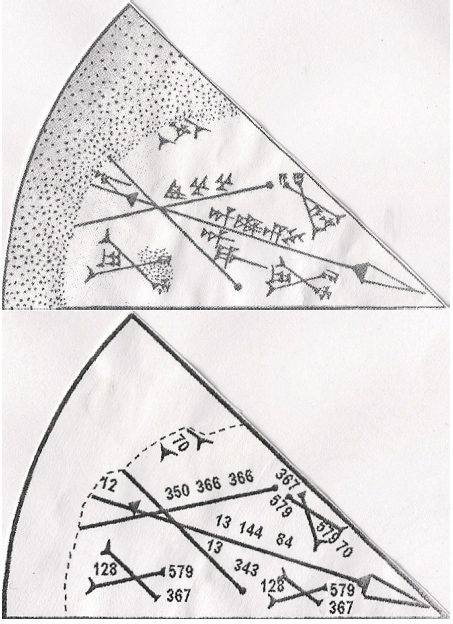
So, when combining the great Sumerian knowledge about comets and their 3,600 year time unit, one obvious question appears: "is the Shar unit just a coincidence or is it actually based on an astronomic constant, like a cometary cycle?"
The idea of a 3,600 year periodic comet visiting our planet is usually dismissed because of the pull that would be exerted by stars other than the Sun on the comet. The reasoning usually goes as follows:
Based on the only two bits of information we have about such an hypothetical comet which 1/ has an orbital period of 3,600 years and 2/ must pass within 1 AU of the Sun (because, if it doesn't, it can't fly by Earth), we can determine that this hypothetical comet must have an aphelion (the point in the orbit which is furthest from the Sun) of 469 AU (469 times the Earth-Sun distance).So is a 3,600 year stable orbit really impossible? Keep in mind the closest star to us is promixa centauri, about 4.25 light years away, so a comet with a 3,600 year orbit would remain within 2,7 light days from the Sun and at a far greater distance (at lest 570X greater) from other stars. Thus the comet would remain under the gravitational control of the Sun during its whole orbit, including its aphelion.
For comparison, this is 10X the distance between Pluto and the Sun. The Sun's gravity is very weak at 469 AU (that is about 2.7 light days), it would be easy for a passing object or another planet in our solar system to destabilize the comet's orbit and have it thrown into interstellar space.
Observation confirms that comets with a very long orbital period can follow a stable periodic orbit. This is for example the case of the great comet of 1811 (C/1811 F1) which exhibits an orbital period of approximately 3096 years.
So it seems that a 3,600 year periodical comet is theoretically possible and we have discovered that the 14,400 BP (3,600 X 4) event is probably related to a cometary event. So, let's pursue our investigation and focus on the hypothetical manifestation of the cometary cycle that is the closest to us (the closer the date, the more data available).
In other terms, did a cometary event occur c. 3600 (3,600 X 1) years ago?
The 3600 BP (1600 BC) Event
Similarly to 14,400 BP, 3,600 BP was marked by a sudden drop in temperature, as shown by the black vertical line in the GISP2 ice core temperature diagram:
Temperature drop (measured through O18 isotope) is not the only atmospheric parameter of note. In the diagram below, we can see a spike (140 ppm) in sulfate concentration that is about 10 times larger than the background concentration (15 ppm) of the following centuries:
The above suggests that 3,600 years ago, some catastrophic event occurred. Actually, 1628 BC was the year of the eruption of Thera, later known as Santorini, a volcano located in the Eastern Mediterranean sea:
A cataclysmic eruption of Thera (Santorini) was dated to 1628BC from carbon dating of ash, and from tree rings as far away as Irish bogs, and Californian bristlecone pines. The Thera explosion, maybe fifty times larger than Krakatoa [...]Krakatoa is famous for its 1883 eruption. It was so violent that its explosions were heard near Mauritius located 4,800 km (3,000 mi) away. It pressure wave circled the globe three and a half times. Ash was propelled 80 km (50 mi.) high. It killed tens of thousands of people and average temperatures fell by as much as 1.2 °C (2.2 °F) in the year following the eruption.
Source
The eruption of Thera is estimated to have been five times larger than the Krakatoa eruption. But, despite its magnitude, it falls short in explaining the major spike in atmospheric dust that occurred during the first half of the 17th century BC. Actually, Thera seems to have been a very small dust contributor:
If temporal data alone cannot definitively link specific eruptions with distant climate records, other geochemical analysesIf Thera contributed only about 5% of atmospheric dust (sulfate transforming into sulfuric acid in ice cores, hence the reference to acidity in the quote above), then where did the remaining 95% dust come from?
must be used. For example, the ice-core acidity layer contained high levels of sulphate but recent petrological calculations of
the sulphur emissions from Thera account for only 3-6% of the amount expected from the concentration of acid in the ice layer
Source
It appears that Thera was not the only active volcano during this period of time:
Minute shards of volcanic glass recovered from the 1645 ± 4 BC layer in the Greenland GRIP ice core have recently been claimed to originate from the Minoan eruption of Santorini [Hammer et al., 2003]. This is a significant claim because a precise age for the Minoan eruption provides an important time constraint on the evolution of civilizations in the Eastern Mediterranean.Dendochronolgy (based both on Irish oaks and Swedish pines) confirms that the eruption of Aniakchak occurred in the first half of the 17th century. In addition, it provides more reliable datings than ice cores, which make this eruption virtually concomitant with Thera 's:
There are however significant differences between the concentrations of SiO2, TiO2, MgO, Ba, Sr, Nb and LREE between the ice core glass and the Minoan eruption, such that they cannot be correlatives. New chemical analyses of tephra from the Late Holocene eruption of the Aniakchak Volcano in Alaska, however, show a remarkable similarity to the ice core glass for all elements, and this eruption is proposed as the most likely source of the glass in the GRIP ice core. This provides a precise date of 1645 BC for the eruption of Aniakchak and is the first firm identification of Alaskan tephra in the Greenland ice cores.
Source
Tree-ring data has shown that a large event interfering with normal tree growth in North America occurred during 1629-1628 (±65 years) BCE. Evidence of a climatic event around 1628 BCE has been found in studies of growth depression of European oaks in Ireland and of Scotch pines in Sweden. Bristlecone pine frost rings also indicate a date of 1627 BCE, supporting the late 1600s BCE dating.Thera, in the Mediterranean Sea, and Aniakchak, in Alaska, were massive eruptions but apparently they are not the only volcanoes that went active around 1627 BC:
However, McAneney and Baillie argue that there is a chronological error in the Greenland ice core dates with ice core dates being around 14 years too old in the 17th century BCE, thus implying that the eruption of Aniakchak, and not Thera, may have been the cause of the climatic upset evidenced by northern hemisphere tree-rings around 1627 BCE
Source
A study published in 1990 by Vogel and others suggested that the Avellino eruption was responsible in part for the climatic disturbances of the 1620s BC. The latter were verified by tree-ring series and ice-core layers. The authors had just obtained carbon dates of 3360±40 BP, or 1617-1703 calibrated BC. They were suggesting a coincidence of a number of eruptions, such as the Minoan eruption on Santorini.The Avelino eruption refers to an eruption of Mount Vesuvius.It is estimated to have had a VEI of 6, making it larger and more catastrophic than Vesuvius' more famous and well-documented AD 79 eruption, that wiped out Pompeii.
In the same paper, Vogel et al. discovered that Mount Saint Helens also went through a major eruption during the 17th Century BC.
Now, we have four major and nearly simultaneous eruptions (Thera, Aniakchak, Vesuvius and St Helens) happening ca. 1628 BC, or as Vogel puts it "a coincidence of a number of eruptions", but it still doesn't account for the full acidity spike found in ice cores:
If aerosols from Avellino approximated that of the very similar AD 79 eruption, they would have been predominately sulphurous and three times more abundant than those from the larger Theran eruption. Mount St Helens Yn may have yielded only half as much sulphate as Thera, but Aniakchak II could have produced sulphur emissions four times greater than Thera's.From the ratios suggested by Vogel, we can deduce the following:
Vogel et al., 1990
- Thera contributing about 5% of total atmospheric dust,
- Vesuvius (Avellino) 15%,
- St Helens 2.5%,
- Aniakchak 20%.
So, those four eruptions, despite their exceptional magnitude, only account for about 42% of the total atmospheric dust found in ice cores.
Notice also that those four volcanoes are located in the Northern Hemisphere. The southernmost one being Thera at 36°N longitude while Saint Helens and Aniakchak are above 45°N.
Despite this concentration of volcanic activity in the North, the diagram below shows that the c. 1,620 BC SO4 spike is almost four times larger in Antarctica ice core (620 ppm see red arrow ) than it is in Greenland ice core (180 ppm - see blue arrow):
So what could explain the prevalence of atmospheric dust in the Antarctic while eruptions occurred in the Northern Hemisphere? What could explain the 58% of unaccounted for atmospheric dust? What could explain the occurrence of, at least, four virtually simultaneous major eruptions?
A cometary event is a prime candidate because direct impacts, along with overhead explosions, can generate a lot of atmospheric dust and, as we will later see, there is a proven correlation between cometary activity and volcanic activity.
Cometary activity is obviously a plausible cause, but is there any trace of such activity in the records of the time? Actually, Chinese writers report such an event:
According to the Bamboo Annals, "In [king Jie's] 10th year, the five planets went out of their courses. In the night, stars fell like rain. The earth shook. Later in the text, the Bamboo Annals state , "The sky was overspread with mists for three days." The mists occurred during the reign of king T'ae -Këah (T-ae Che or Tai Jia), the fourth ruler of the Shang dynasty, who was enthroned c. 1530 BC. The reign of king Jie of Xia, which ended in approximately 1600 BC, and the reign of king T'ae -Këah of Shang, which occurred nearly seventy years later (based on the chronology offered in the Bamboo Annals ) both occurred within the c. 1670-1520 BC radiocarbon date range of Thera and the ice-core and tree-ring range of c. 1740-1440 BCSo, the Chinese annals appear to have recorded something akin to a close cometary passage at the time of the 1600 BC events. Notice also the mention of earthquakes ("the Earth shook"). As noted, cometary events are closely correlated with seismic activity (along with volcanic activity).
Source
The "stars falling like rain" as reported by the Bamboo annals was obviously not a minor event because 1600 BC also marked the end of the Xia dynasty, which had ruled over Eastern China for four centuries.
At this point, there is a lot of data to support the occurrence of a cometary-induced catastrophe c. 1628 BC. The main counter-argument being the Egyptian records. There is no trace of a catastrophic event c. 1628 BC in those documents, although there are catastrophes ascribed to different dates.
But how much credence should we give to Egyptians records, and its highly controversial and still debated chronology that was designed to match the Old Testament which is, in itself, a bundle of mythical accounts, not real history? The fictional character of the Old Testament is now an established fact:
It's long been known that most of the OT [Old Testament] is fiction (Exodus, Job, Ruth) or forgery (Daniel, Deutero-Isaiah, Deutero-Zecharia).
Richard Carrier, On the historicity of Jesus, p. 215
The 7200 BP (5200 BC) Events
Now that we have provided data suggesting the possible occurrence of comet-induced catastrophes ca. 14,400 BP (3,600 X 4) and ca. 3,600 BP, let's have a look at the intervening date of ca. 7,200 BP (3,600 X 2).
Similar to 14,400 and 3,600 BP, we discover a sharp temperature drop revealed by ice core analysis, as depicted by the black vertical line in the graph below:
7,200 BP is also marked by an exceptional spike in mercury (Hg) concentration. The picture below shows the concentration in titanium, bromine and mercury found in EGR2A, which is a 6 meter long peat core from Switzerland that spans from 12,500 BP to now. It reveals the largest concentration of mercury at 7265 ± 75 BP, as indicated by the red circle:
Mercury is a very rare element on planet Earth, its bulk abundance is estimated by Mc Donough et al. to 3-8 ppb (parts per billion). However, in meteorites, mercury concentration is much higher albeit quite variable with concentrations ranging from ca. 10 ppb to 14,000 ppb.
The record 14,000 ppb concentration was found in the Orgueil meteorite, a 14 kg (30 pounds) carbonaceous chondrite meteorite which fell in Southern France in 1864.
According to Gounelle et al., the Orgueil meteorite has a cometary origin, which is also the case for some other carbonaceous chondrite meteorites as suggested by Haack et al.
The connection between comets and high mercury concentration is reinforced by the analysis of impact craters on the Moon:
High Hg [mercury] abundances in these deposits were suggested by Reed (1999), and confirmed in the plume ejected from the floor of the lunar polar crater Cabeus by a kinetic impactor (the LCROSS mission; Gladstone et al., 2010). The lunar soil in this crater was found to contain 2,000,000 ppb Hg!The floor of the lunar crater Cabeus exhibits a mercury concentration of 2,000,000 ppb, which is equal to 0.2%. That concentration is about 300,000 larger than the average mercury concentration found on Earth.
Meier et al., Mercury (Hg) in meteorites: Variations in abundance, thermal release profile, mass-dependent and mass-independent isotopic fractionation, 2016
In addition to an unusual mercury spike and its probable cometary origin, 7,200 BP is also marked by a sudden increase in atmospheric dust. indicated by the high sulfur (SO2) concentration discovered in the GISP2 (Greenland) ice core:
The diagram above shows SO2 concentration (sulfur dioxide - atmospheric aerosol used as proxy for biomass burning and volcanic activity). The black arrows show the 7,200 BP date and massive SO2 spikes that are the 4th largest signals over the past 70,000 years.
The 53rd century BC was a period of sudden increased volcanic activity as shown by the diagram below displaying the number of major eruptions per century found in four different ice cores: EPICA (Antarctica), Plateau Remote (Antarctica), GISP2 (Greenland) and SDMA (Siple Dome A in Antarctica). The 5,200 BC (7200 BP) spike in number of eruptions, about 15 major events within one century, is shown by the vertical turquoise line:
If we look in more detail at this period of time, the timing of the sulfate release attributed to volcanic eruptions is as follow: the first number is the year (BC), the second number (in parenthesis) is the concentration in SO4 (ppm).
The original paper from which this data comes lists only the volcanic events that released more than 25 ppm of SO4. Most centuries are very quiet with a total SO4 release below 100 ppm, but the 53rd century BC exhibits more than 1264 ppm of cumulated sulfate release.
This sulfate spike is explained by volcanic eruptions. Namely, the 5,277 and 5,279 sulfate releases are attributed to the Kizimin volcano located in Kamchatka, Russia.
Notice the magnitude of the SO4 concentration in the 5,277 and 5,279 layers which reach a total of almost 1,100 ppm. That is about eight times the SO4 signature left by Thera in 1,628 BC or 40 times the Krakatoa signature from the 1883 eruption.
Nevertheless, there are two problems with the Kizimin hypothesis. First, the carbon dating of the Kizimin eruption is not very accurate and is set between 5,600 and 5,000 BC. Second, as shown by the SO4 concentration diagram above, ice cores reveal a 720 ppm SO4 concentration while Kizimin only released 677 ppm.
The above raises several questions: was Kizimin the sole contributor, or contributor at all, to the 7,200 BP sulfate spike? What triggered the wave of virtually simultaneous volcanic eruptions?
In any case, the 7,200 BP event left marks on human activity, despite a scarcity of archeologic sites for this period of time. One of those sites is Çatalhöyüki in Anatolia (Turkey) which was founded ca. 7,500 BC and flourished for 22 centuries, until its abandonment c. 5,300 BC:
The settlement [Çatalhöyük] was then abandoned around 5300 B.C.While Çatalhöyük is the most notable site, numerous other neolithic sites were abandoned in 7,200 BP.:
Mary Settegast. Plato Prehistorian. The Rotenberg Press. 1987, p.207
- In Turkey, the Hacilar and Mercin sites
- Yarim Tepe and Hajji Tepe in Iran
- The site of Ban Rai in Vietnam after 34 centuries of activity
- The Chertovy Vorota Cave in Russia first occupied 22 centuries earlier.
7,200 BP also witnessed the end of the Fayium A in Egypt, the Amuk B period in Syria, the pottery neolithic in the Levant, the Hassuna culture in Assyria.
The 10,800 BP (8,800 BC) Event
At this point we have examined the 14,400 BP (4 X 3,600), the 3,600 BP event and the 7,200 BP (2 X 3,600) event. Only one date remains: the 10,800 BP event (3 X 3,600).
Just like the three preceding dates, we notice a sudden drop in temperatures around 10,800 BP:
The diagram above is a temperature reconstruction based on a Vostok (Antractica) ice core. We can see a pink arrow showing a temperature drop ca. 10,800 BP. Notice that this temperature drop is moderate (about 0.5°C) compared to the three other events. In addition, this temperature change does not appear in the Greenland ice core. We'll see later why the temperature increase was so limited and localized.
Along with the temperature drop, 10,800 BP reveals a spike in NO3 (nitrate):
As shown in the diagram above, both Belukha (Siberia) and Taylor Dome (Antarctica) show a spike in nitrate (NO3) ca. 10,800 BP. The spike in Belukha (+15 ppb) is more pronounced than in Taylor Dome (+ 6 ppb). NO3 is a biomass-burning proxy as shown by Brook et al. 2015.
Other combustion aerosols are acetate oxalate, NH4 and formate. As shown in the diagram below, each displays a sharp rise starting from 10,800 BP, symbolized by the red vertical lines, while the red arrows indicate the subsequent concentration spikes:
This increase is not as pronounced as at the onset of the Younger Dryas (c. 12,800 BP) but it is still identifiable. Notice that the GRISP ice core comes from Greenland.
The diagram below shows the concentration in titanium (Ti - light grey curve), bromine (Br - medium gray curve) and mercury (Hg - black curve) found in EGR2A, a 6 meter long peat core from Switzerland that spans the period 12,500 BP until now. It reveals one of the largest concentrations of titanium (green dot), bromine (purple dot) and mercury ca. 10,800 BP
We have previously described the high concentration in mercury found in meteorites and impact craters.
Coincidentally or not, asteroids are also rich in titanium. As shown in the table below, titanium is one of the very few elements found in every single class of meteorites. Its concentration is particularly high in the following classes: Orthopyroxene, Clinopyroxene, Chromite and Phosphate. 10,800 BP also reveals the largest concentration in bromide over the past 12,500 years. Bromide concentration in Earth's crust is low, about 1 ppm, which is similar to the bromide concentration found in Meteorites.
So, where does the 40 ppm bromide spike found ca. 10,800 BP come from?
With 0.0065% (65 ppm) the ocean exhibits much higher bromide concentration than the Earth's crust. However, the 40 ppm bromide spike was not found on sea shores but in a peat core collected at Etang de la Gruere, Switzerland, hundreds of kilometers from the nearest coast.
Could an asteroid impact in the ocean explain this unexpected bromide spike found in Switzerland? The research conducted by Pierazzo et al., suggests that asteroid impacts in the ocean:
1/ increase the atmospheric bromide concentration 20 times
2/ spread the atmospheric bromide over continents
The impact of a 500 m asteroid [in the ocean] increases the upper atmospheric water vapor content by more than 1.5 times the background over a wide region surrounding the impact point for the first month after the impact. Halogens, ClY and BrY [bromide compounds], follow the water vapor distribution, with an initial increase of over 20 and 5 times normal background, respectively, in the same region surrounding the impact. The perturbations eventually spread over the northern hemisphere, where water vapor content remains about 50% above background for the first year after impact, while ClY and BrY exceed five times and twice their background valuesAn oceanic impact would explain, on one hand the large bromide spike and on the other the moderate temperature drop because oceanic impacts generate far less dust than ground impacts.
Pierazzo et al., Ozone perturbation from asteroid impacts in the ocean,
The relatively low concentration of atmospheric dust c. 10,800 BP is confirmed by the diagram below. The 10,800 BP signal is indicated by the turquoise arrow with a SO4 level reaching about 150 ppm. Notice for comparison the purple arrow, showing the previously described 7,200 BP event, which reveals a 750 ppm SO4 spike.
The events that left their mark on Earth's atmosphere ca. 10,800 BP, also left their trace on fauna:
An extensive but discontinuous charcoal layer, dated to 10,840 ± 80 and 10,960 ± 60 BP, may mark the arrival of fire-starting humans. Whether or not the burning was anthropogenic. Above this lens, two beveled-based bone points, a reworked Gainey like nuted point, and two possibly human-altered bones (a cut snapping turtle vertebra and a perforated ilium of a peccary) were found within a ca. 2 m2 area. Based upon overlying dates (unfortunately including a few anomalies due to evident water disturbance), the cultural material seems to date to ca. 10.800 - 10,900 BP. The dated samples from the overlying strata include two bones of the extinct flat-headed peccary (Piatygouus compressus) (11,130 ± 60 and 11,060 ± 60 BP) a bone of extinct giant beaver (Castoroides ohioeusis) (10.850 ± 60 BP), and a bone of caribou (Rangifer taraudus) dated to 10.440 ± 40 BP. The Iater is obviously not an extinct species but it's been quite a while since caribou lived in Ohio.As emphasized by Thomson et al. in their conclusion about the extinction of ground sloths: "they were under no evident dietary stress at the time
Several caves in the Southwest contain stratified dated sequences that are merely suggestive of a Terminal Pleistocene catastrophe, because no evidence of human habitation or butchery is present. In these sites, steady deposition of dung through millennia by Shasta ground sloth (Nothrotheriops shastensis), stops abruptly at 11,000-10,800 BP. Relatively precise terminal dates on dung include: Gypsum Cave, NV. 11,005 ± 100, 11,080 ± 90 BP (Hofrciter et al. 2000); Rampart Cave, AZ 10.940 ± 60, 11,000± 140 BP; MuavCaves, AZ 11140± 160, 11.060±240, 10,650 ± 220 BP, Aden Crater, NM, 11.080 ± 200 BP, Upper Sloth Caves, TX, 10,750 ± 140, 10,780 ± 140 and 11.060 ± 180 BP (Long and Martin, 1974; Martin. 2005).
G. Haynes, American Megafaunal Extinctions at the End of the Pleistocene, 2008, p.30
of extinction".
Mystery Eruption
So far in our analysis, sulfur/dust spikes (SO2, SO4) found in ice cores have been frequently mentioned. From the point of view of mainstream science, sulfur spikes are exclusively a proxy for volcanic eruptions. That is, if a sulfur spike is found, it is due to a specific volcanic eruption(s).
The problem, however, is that even in the recent past, most sulfur spikes remain unexplained because there are no matching volcanic eruptions to be found. The diagram below lists the 92 notable sulfur spikes that occurred over the past 2000 years. More than half of them (47 spikes - yellow highlighted), are not attributed to any eruption and the remaining 45 spikes are only "possibly associated" to this or that eruption.
The further back we go in time, the worst it gets. The diagram below shows SO2 concentrations in the GISP2 (Greenland) ice core over the past 16,000 years :
It shows 62 spikes that reach more than 120 ppm. Some of the spikes reach 800 ppm. For comparison the "giant" Krakatoa eruption generated about 150 ppm of sulfur.
Out of the 62 major spikes, only 14 are tentatively associated to a volcanic eruption. The two largest ones (-10,657 BC and -9,285 BC) have no associated eruption whatsoever: In the diagram above we can see the yellow highlighted 1258 AD spike (almost 400 ppm). A few volcanoes have been suspected (Chichon, Quilotoa, Harrat Rahat) but the dating of their eruption doesn't match. Up to now, no volcanic eruption has been attributed to the AD 1258 spike:
The largest eruption of the historic period, possibly of the past 7000 years, probably occurred in AD 1257. Its estimated magnitude (1014-1015kg) and caldera diameter (10 - 30 km) make it surprising that the volcano responsible has not been identified, but investigations of candidate young calderas, and the marine core record, may ultimately reveal the source. Palaeoclimate reconstructions indicate austral and boreal summer cooling in AD 1257 - 59, consistent with a high sulphur yield, low-latitude explosive eruption occurring in AD 1257. The 5×1013kg Baitoushan eruption probably took place ca. AD 1030. Other large, unidentified, climate-forcing eruptions occurred in ca AD 1100, 1171, 1229 and 1341A sulfur spike is attributed to a volcanic eruption simply by matching the dating of dust found in the ice core with the dating of the suspected eruption. This approach doesn't prove that the eruption caused the dust spike, just that the dust spike and the eruption were "relatively" synchronous.
Oppenheimer et al., Ice core and palaeoclimatic evidence for the timing and nature of the great mid-13th century volcanic eruption, 2003
I used the term "relatively", because the carbon dating of eruptions (analysis of lava layers) is approximate and exhibits about a 5% uncertainty margin. This means that an eruption carbon dated back to 10,000 BP actually happened within a 90% certainty between 10,250 BP and 9,750 BP. It's a five century uncertainty margin and it's not even sure the eruption falls within this bracket.
So, the 14 "explained" spikes out of the 65 spikes listed over the past 16,000 years are just hypothetical explanations, where an eruption dating was 'close enough' (here we're talking about decades or centuries of uncertainty) to the dating of a spike. And even if the identified eruption indeed contributed to the spike, nothing proves it was the main, much less the sole contributor of the spike.
A case in point is the 1628 BC event. For a long time, Thera was considered as the sole culprit. Because of the historical interest and time proximity of the event, further research was conducted involving detailed analysis of the dust found in ice cores (isotopes, ratios, spectroscopy) that showed that at least three other volcanoes were involved.
Thera was not the sole contributor and, as shown above, there were other contributors besides the four eruptions recently identified.
Another example is the onset of the Younger Dryas ca. 12,800 BP. For years it was considered by most scientists as a purely volcanic event. Despite the overwhelming evidence of cometary bombardments, it is still attributed today by some mainstream scientist to volcanic activity exclusively.
The confusion between major volcanic eruptions and cometary events is understandable because their "macro" markers are quite similar:
- a spike in atmospheric aerosols (SO2, SO4, NH4, NO3, ...), most of those aerosols being proxies of the burning of biomass, whether comet or volcano induced.
- a sudden global temperature decrease (because of the above mentioned atmospheric dust)
The identification of massive cometary bombardment as the main trigger of the YD c. 12,800 BP is due to the discovery of craters combined with their precise dating and their detailed examination that revealed some specific material (microspherule, fullerene, platinium, titanium, carbon glass, iridium, nanodiamond).
Since most of these materials are only found in impact craters and not in volcanoes, scientists could dismiss the volcano-only hypothesis.
But this raises another important question: How many dust spikes/temperature drops are wrongly attributed to volcanic eruptions?
Worringly, the mystery eruptions (dust spike to which no eruption is attributed) don't only apply to very old spikes. As recently as 1808, we encounter one of those 'mystery eruptions'. The data is clear, a sulphate spike started around december 1808:
Notice that the spike starting around December 1808 (turquoise arrow) is almost as tall as the spike left by the 1815 Tambora eruption, which was the most powerful eruption in human recorded history, with a Volcanic Explosivity Index (VEI) of 7.
In addition to an obvious dust spike, the 1808 event also reveals a subsequent temperature drop:
The diagram above shows that 1808 was marked by a drop in oxygen 18 (a proxy for temperature drop - see green arrow) concomitant with a sudden rise in magnesium (red arrow). Keep this point in mind, we'll address it soon.
Because of its relatively recent occurrence, there are eyewitness reports of the 1808 event. Francisco José de Caldas, director of the astronomical observatory of Santa Fe de Bogotá (Colombia), reported the following:
As of 11 December of last year [1808], the disk of the sun has appeared devoid of irradiance, its light lacking that strength which makes it impossible to observe it easily and without pain. Its natural fiery colour has changed to that of silver, so much so that many have mistaken it for the moon. This phenomenon is very noticeable at sunrise, and particularly when the sun sets. When [the sun] is at its zenith, it shines more brightly and cannot be looked at with the naked eye. Near the horizon, it has been seen to take on a light rosy hue, [or] a very pale green, or a blue-grey close to that of steel. [. . .] The whole vault of the sky has been covered by a light cloud as widespread as it is transparent. [. . .] [Also] missing have been the emphatic coronas which are so frequently seen around the sun and the moon when those clouds that meteorologists know by the name of veil are present. The stars of the first, second and even the third magnitude have appeared somewhat dimmed, and those of the fourth and fifth have completely disappeared, to the observer's naked eye. This veil has been constant both by the day and by night.The veil event was not limited to Colombia, it was also reported by physician José Hipólito Unanue who was located in Lima, Peru (2600 km from Bogota):
Guevara et al., 2014
At sundown in the middle of the month of December [1808], there began to appear towards the S.W., between cerro de los Chorrillos and the sea, an evening twilight that lit up the atmosphere. From a N.S. direction on the horizon, it rose towards its zenith in the form of a cone, [and] shone with a clear light until eight [o'clock] at night, when it faded. This scene was repeated every night until the middle of February, when it vanished.Notice that nowhere is an eruption mentioned. Despite this, until now, a volcanic eruption remains the sole hypothesis despite the absence of a fitting candidate. Indeed, Urzelina volcano, Tall volcano and Putana volcano present eruption dates that don't match the timing of this observed 'veil'.
Guevara et al., 2014
So what we can say about the 1808 mystery event is that it involved:
- a spike in atmospheric aerosols (sulphur and magnesium)
- a subsequent temperature drop
- witnesses reporting an atmospheric veil spanning at least 2,600 km
These three features are typical of an overhead cometary explosion or an intense meteor shower. Coincidently or not, three comets were observed in 1808. These are namely C/1808 M1, C/1808 F1 and 26P/1808 C1. They all were discovered by French astronomer J.L. Pons from Marseille observatory.
The latter of these three comets is also known as comet Grigg-Skjellerup, whose nucleus is estimated to be 2.6 kilometers in diameter. Grigg-Skjellerup is a periodic comet (about a five year cycle), whose perihelion is about 1 AU (astronomical unit) from the Sun. 1 AU being the distance between the Sun and the Earth.
Having its perihelion so close to Earth's orbit made it an easy target for the Giotto space-probe mission in 1992, whose closest approach to Grigg-Skjellerup was only 200 km. The diagram below shows how the orbits of Comet Grigg (brown) and planet Earth (blue) are almost the same:
Also, it was discovered that Comet Grigg produces a meteor shower that periodically hits the Earth's atmosphere. This meteor shower is called Pi Puppids, concomitant with comet Grigg's perihelion.
The picture above shows a recent occurrence of the Pi Puppids (2018), in the past it seems that the Pi Puppids was a more intense meteor shower.
Now, remember the above-mentioned magnesium spike found in an Antarctic ice core from ca. 1808 AD?
Interestingly, magnesium is the most abundant element found in some comets. During its flyby near Comet Halley, space probe Giotto measured the composition of the comet through spectroscopy. The results revealed that magnesium (isotope 24, 25 and 26) was by far the most abundant element, as shown by the diagram below where the magnesium spikes are circled in red:
Comet Halley is not an isolated case. High concentrations of Magnesium are found in most Jupiterian comets. This applies to Comet Grigg-Skjellerup too, whose radar analysis revealed high concentrations of olivine, a magnesium-rich silicate:
Yet again we must ask the question: how many so-called 'mystery eruptions' are actually cometary events, whether through direct impact or overhead explosion?
Correlation Between Cometary Activity And Volcanic Activity
So far we have suggested that some dust spikes are probably wrongly attributed to volcanic eruptions, when they more likely to be the result of cometary events.
But volcanic activity and cometary events are not mutually exclusive. In the following, we will discover that there is a clear correlation between vulcanism and cometary activity, and even more: cometary activity can be a direct cause of volcanic eruptions.
This idea is nothing new. In antiquity, philosophers considered comets as the trigger of volcanic eruptions and other calamities:
The philosophers of antiquity almost universally believed the approach of comet towards the sun to bring pestilence on the surface of the earth, by rousing volcanic fire, and by disturbing the atmosphere.For hundreds of years this ancient knowledge was labeled as groundless superstition and thoroughly suppressed by modern science and its uniformitarian dogma where life on Earth is disconnected from cosmic events.
T. Forster, Illustrations of the atmospherical origin of epidemic disorders of health, 1829
However, over the past few years, several publications have acknowledged the positive correlation between comets and volcanic eruptions/earthquakes through some kind of electric connection.
A paper published in 2015 established that cosmic and solar radiation are a cause of volcanic eruptions and earthquakes:
The bottom line is that all earthquakes and volcanic eruptions-big or small- are triggered by an external pressure induced on Earth's magnetic field. Strong Coronal Mass Ejection Flare directed at Earth can exert pressure, that deform and shrink the Magnetosphere by as much as 4 Earth Radius (4Re). But, the pressure would affect or impact the layers of Earth below its surface in different ways. It depends on the tectonics of each region. In some regions the tension would cause energy to be released in the form of earthquakes, while in others it would be in the form of volcanic eruptions.The above shows that indeed quakes and eruptions are similar phenomena in that they release tectonic energy. It also shows that Solar activity causes changes in Earth's tectonic energy. What it doesn't do is provide any explanation about what modulates Solar activity itself. Omerbashich et al., provided part of the answer when they discovered a strong correlation between major earthquakes and cometary activity:
To add to my solution's robustness, I include alignments to the comet C/2010 X1 (Elenin) as it is the only heavenly body currently in our solar system besides planets, and show that it impacted very strong seismicity since 2007 (and strongest seismicity, perhaps since 1965).The correlation between major earthquakes and alignment with Elenin is particularly striking. Of the 12 major earthquakes that occurred between April 2007 and March 2011, half of them (including the March 11th, 2011 M9.0 Japan earthquake) involve Elenin alignment as shown in the table below (Elenin is highlighted in yellow):
To understand how cometary activity in the Solar system triggers vulcanism and seismicity, one has to understand the electric nature of the cosmos. Here is a very brief summary of the electrical mechanisms of comets that can induce volcanic eruptions. The following is extracted from Earth Changes and the Human-Cosmic Connection which provides much more detail on the topic.
The Sun is electrically active, it is positively charged. It is surrounded by an electrically negative layer (heliosphere) that extends beyond the Solar system as shown in the diagram below:
The sun-heliosphere couple acts like a giant capacitor that is discharged by planetary alignments and/or foreign objects entering the solar system, in the same way a bug zapper discharges when a mosquito flies inside it.
A prime candidate for triggering such solar discharges are comets, because they are electrically very active (as indicated by their intense glow) and have conductive plasma tails that extend hundreds of millions of kilometers.
When a comet triggers a discharge of the solar 'capacitor', the Sun releases Coronal Mass Ejecta (CME) which are massive quantities of protons (positively charged particles). These discharges, if properly oriented, can reach Earth. The diagram below depicts the effect of such discharges on our planet:
On the right of the image, solar activity is weak; therefore the Earth receives little (positively charged) solar winds (small yellow arrow). As a consequence, the electric potential of earth's ionosphere is less positive and it tends to attract fewer free electrons from the Earth to its surface, making it less negatively charged. As a result, the Electrical field between the ionosphere and the Earth's surface (atmospheric E-field) is reduced (small orange arrow on the right picture).
With fewer free electrons attracted from the inside of the Earth to its surface, the electric field between the Earth's surface and its core is also lowered (small red double arrow on the right picture).
This electric field is the binding force of the planet, it 'holds the planet together'. A brutal solar discharge can induce a sudden spike in the positive charge of the ionosphere, which translates into a sudden surge in the binding force. A crude but accurate enough analogy is if you were to hold an orange in your hand and then suddenly squeeze it.
This 'planet squeeze' is not the only effect of cometary triggered solar discharges. The Earth's spin is powered by the Sun too. When the Earth is hit by a solar discharge, it goes through a minute acceleration. Such acceleration can have two consequences:
- a minute crustal slippage. The density of the crust is lower than the density of the mantle, therefore, the crust and the mantle won't slow down at the same rate. The mantle being denser, it has a higher momentum and won't slow down as fast as the crust. The difference in rotation between the crust and the mantle is equal to the crustal slippage. Crustal slippage, and the tremendous stress it exerts on the crust/mantle boundary, is a major cause of vulcanism and seismicity.
- a slight deformation of the shape of our planet. Indeed, as shown in the diagram below (right) the faster our planet spins, the stronger the centrifugal force (red arrows), that deforms Earth into a more ellipsoidal (oval) shape. Conversely, on the left, our planet is subjected to a lower spin frequency, which induces a limited centrifugal force which deforms our planet less and it retains a more spherical shape:
Of course, the minute deformations of our planet caused by variations of Solar activity induces tremendous mechanic stress on the Earth's crust. The direct manifestations of the crust stress are earthquakes and eruptions.
Conclusion
In this article, we have gathered data showing that Earth was probably subjected to cometary events (direct impact and/or overhead explosions and/or electric disruptions) in 14,400 BP, 10,800 BP, 7,200 BP and 3,600 BP.
Consequently, the fact that the Sumerians adopted as one of their main time units the 3,600 year 'Shar', might not be a coincidence after all, but the reflection of a known cosmic cycle.
We have also discovered that cometary events and volcanic eruptions leave very similar traces. In addition, they are not mutually exclusive, both can occur simultaneously for the simple reason that cometary events do indeed cause volcanic eruptions.
Despite this proven causation, mainstream science keeps downplaying the role of cometary events in favor of a systematic recourse to spontaneous (not induced by a comet) volcanic eruptions to explain most catastrophes.
Oxford astrophysicist Victor Clube once said:
Cynics would say that we do not need the celestial threat to disguise Cold War intentions; rather we need the Cold War to disguise celestial intentions!Keeping in mind the confusion between volcanic eruptions and cometary events, we could paraphrase Clube's words as follows:
Victor Clube et al., The Cosmic Winter, 1990
Cynics would say that we do not need the celestial threat to disguise volcanic eruptions; rather we need volcanic eruptions to disguise celestial intentions!To summarize, the evidence suggests that a comet (or cometary swarm) interacted with the Earth ca. 14,400 BP, 10,800 BP, 7,200 BP and 3,600 BP. That is to say, on a 3,600 year cycle, meaning that we are due a repeat performance around now. Indeed, the American Meteor Society's records of observed fireballs worldwide over the past 13 years suggest that the 'show' might actually have already begun:


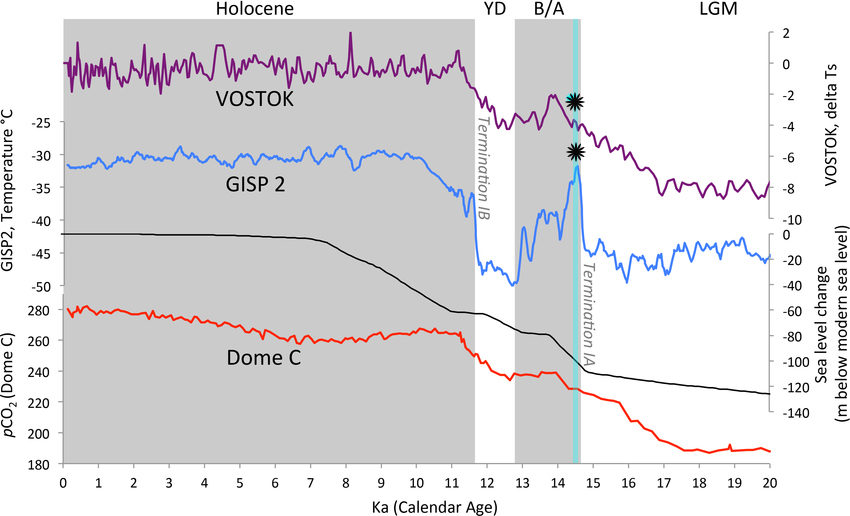

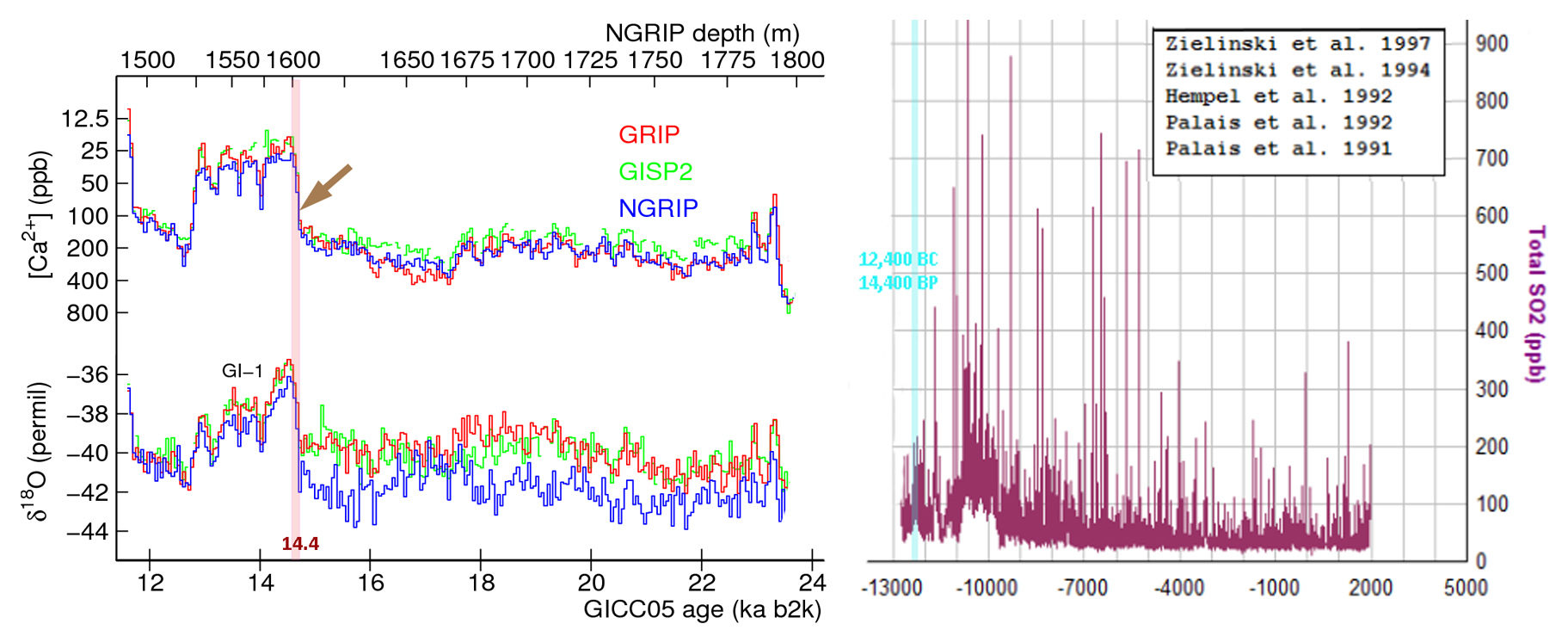



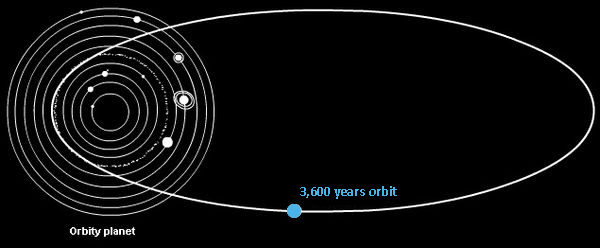
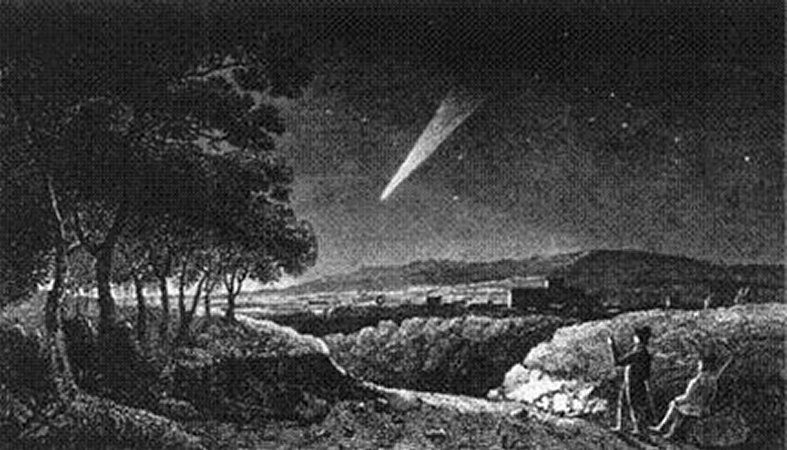
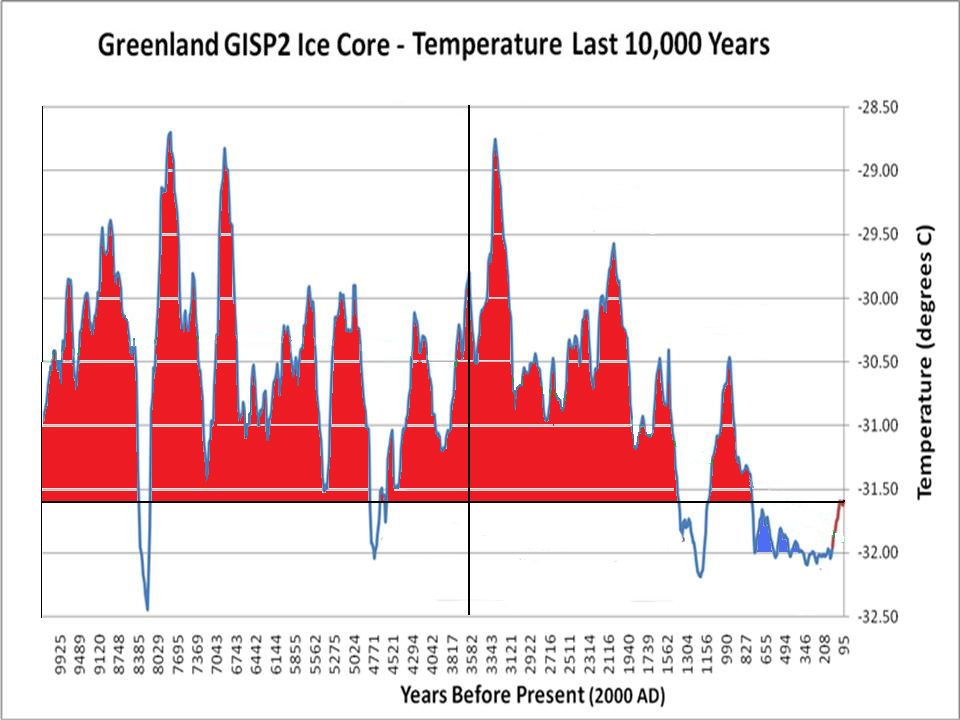
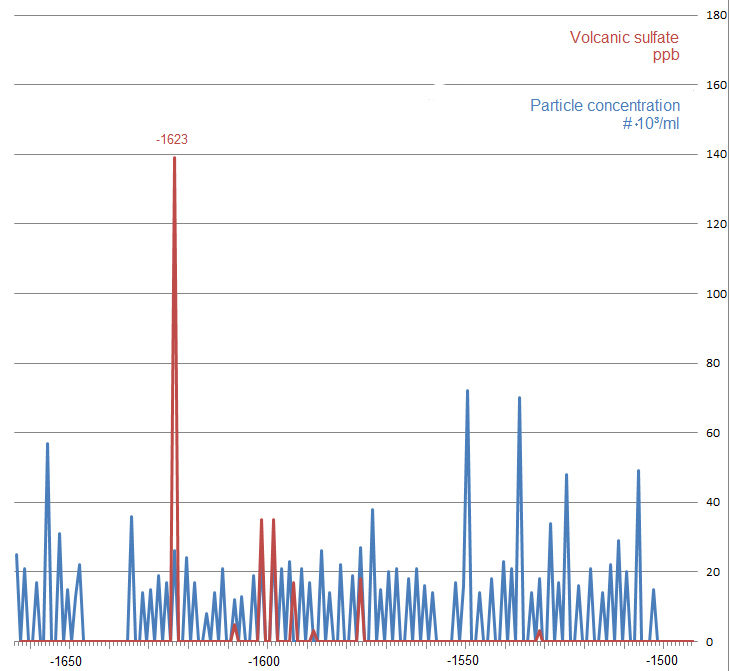

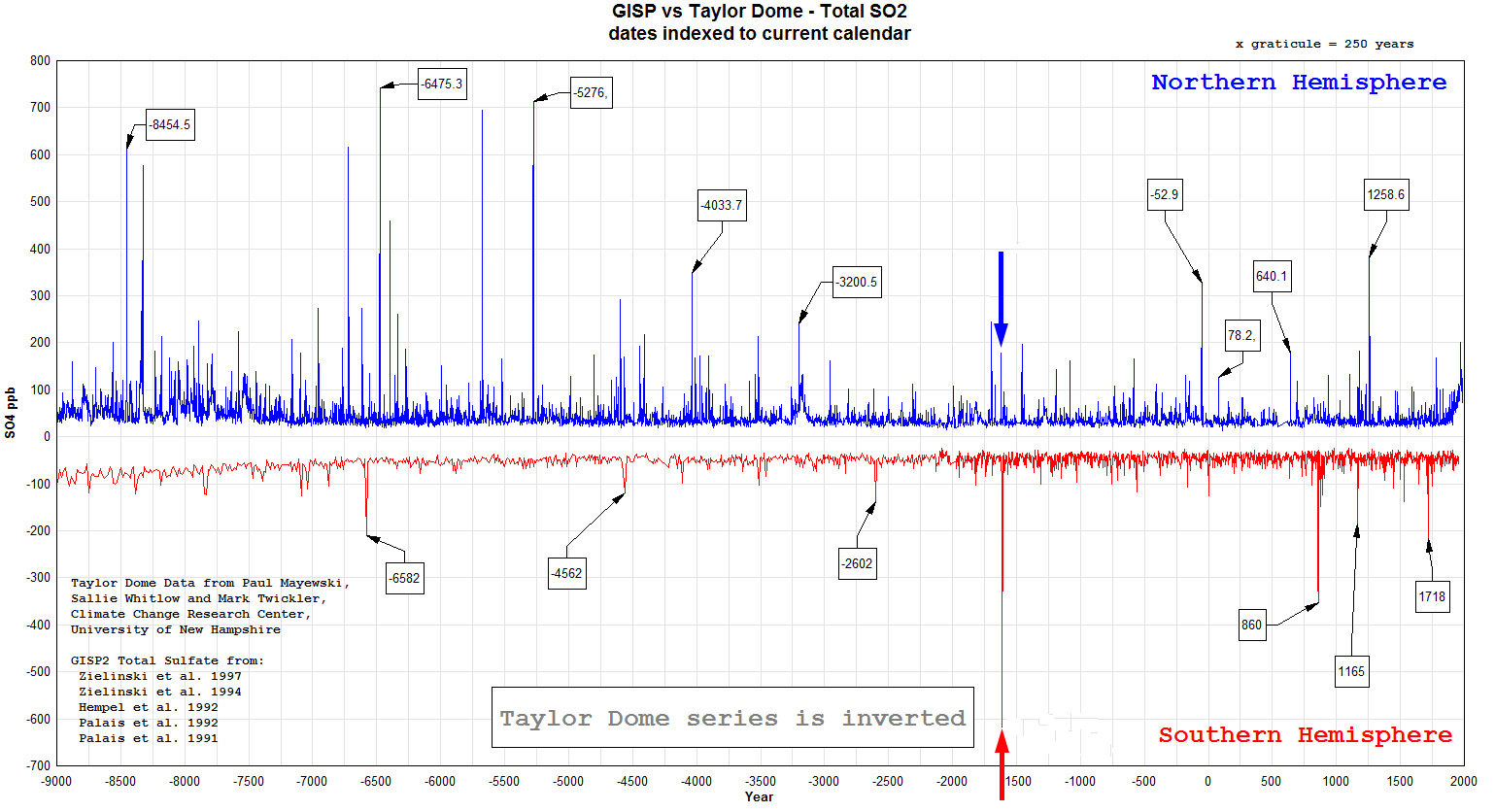
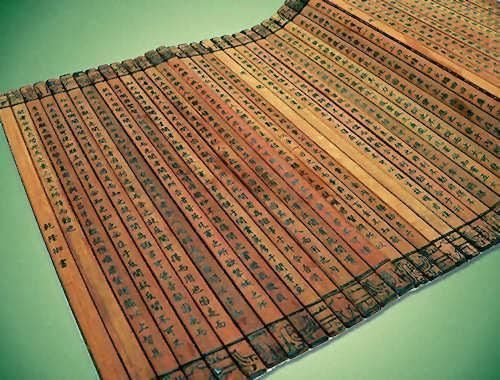
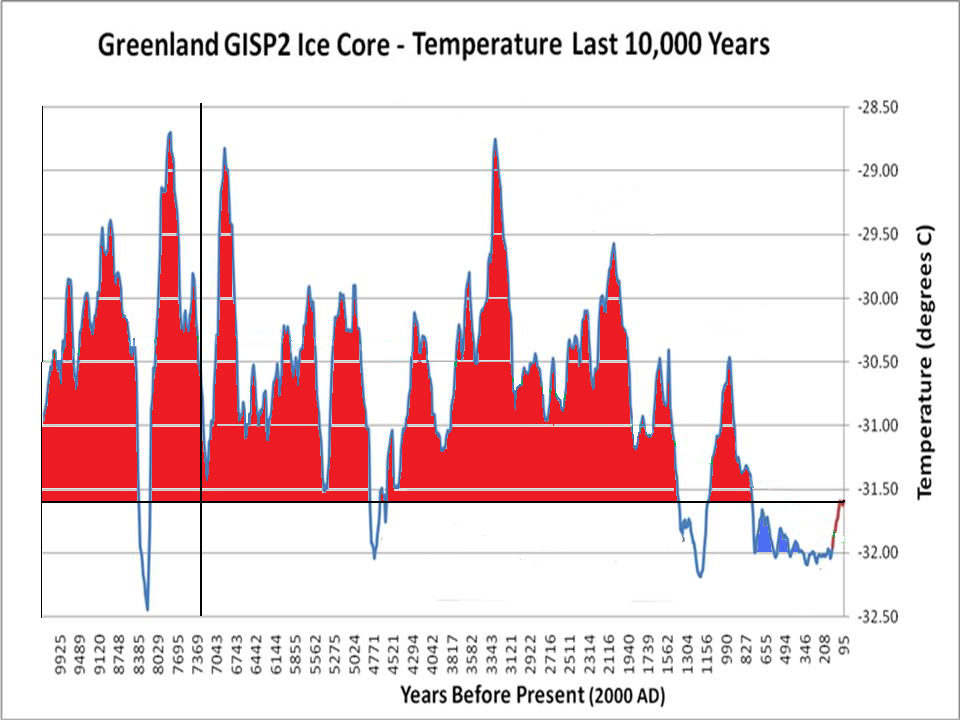

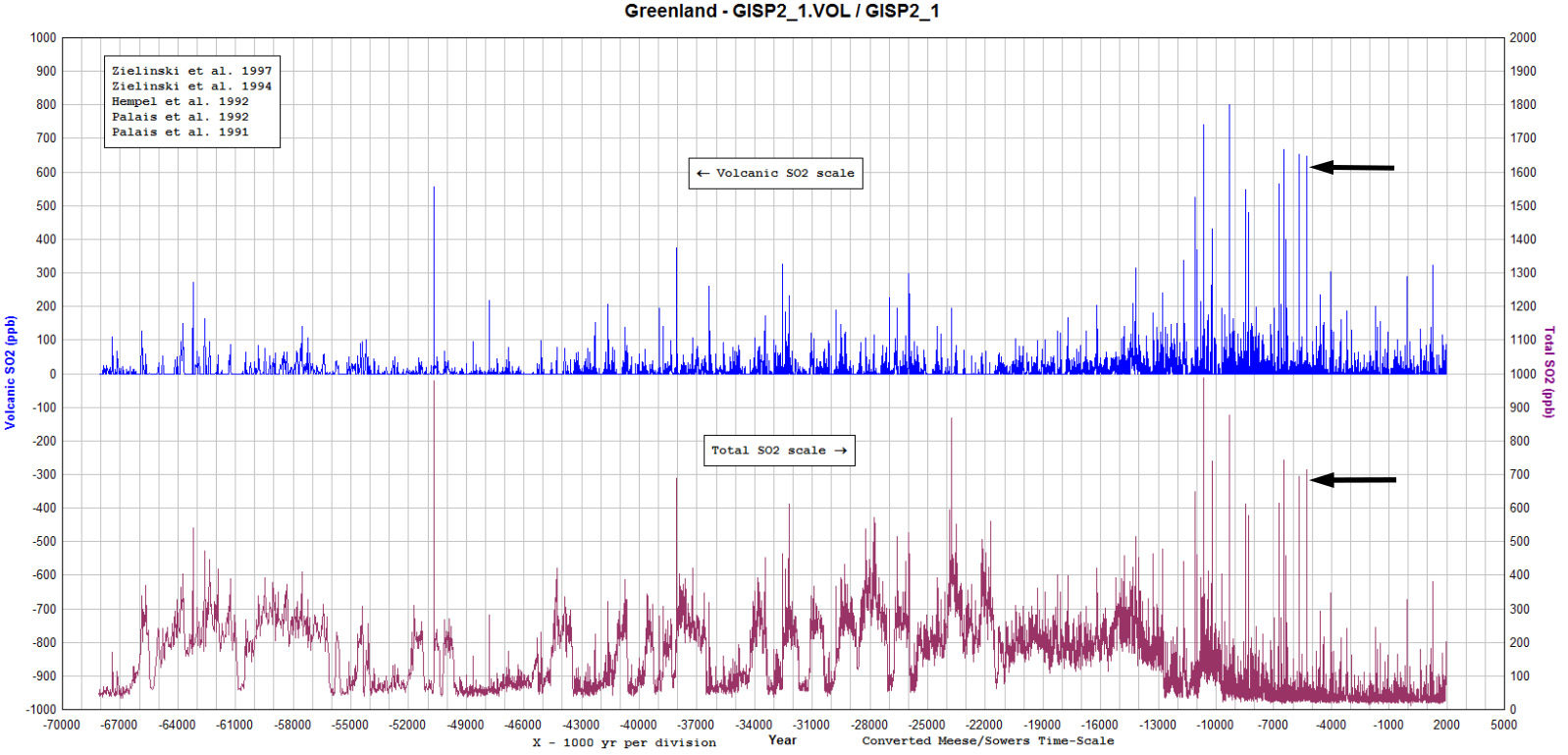
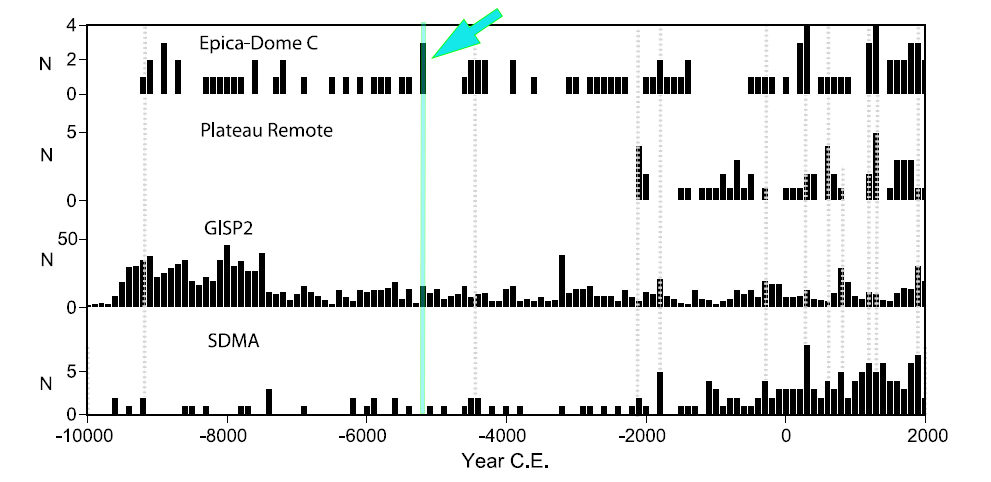

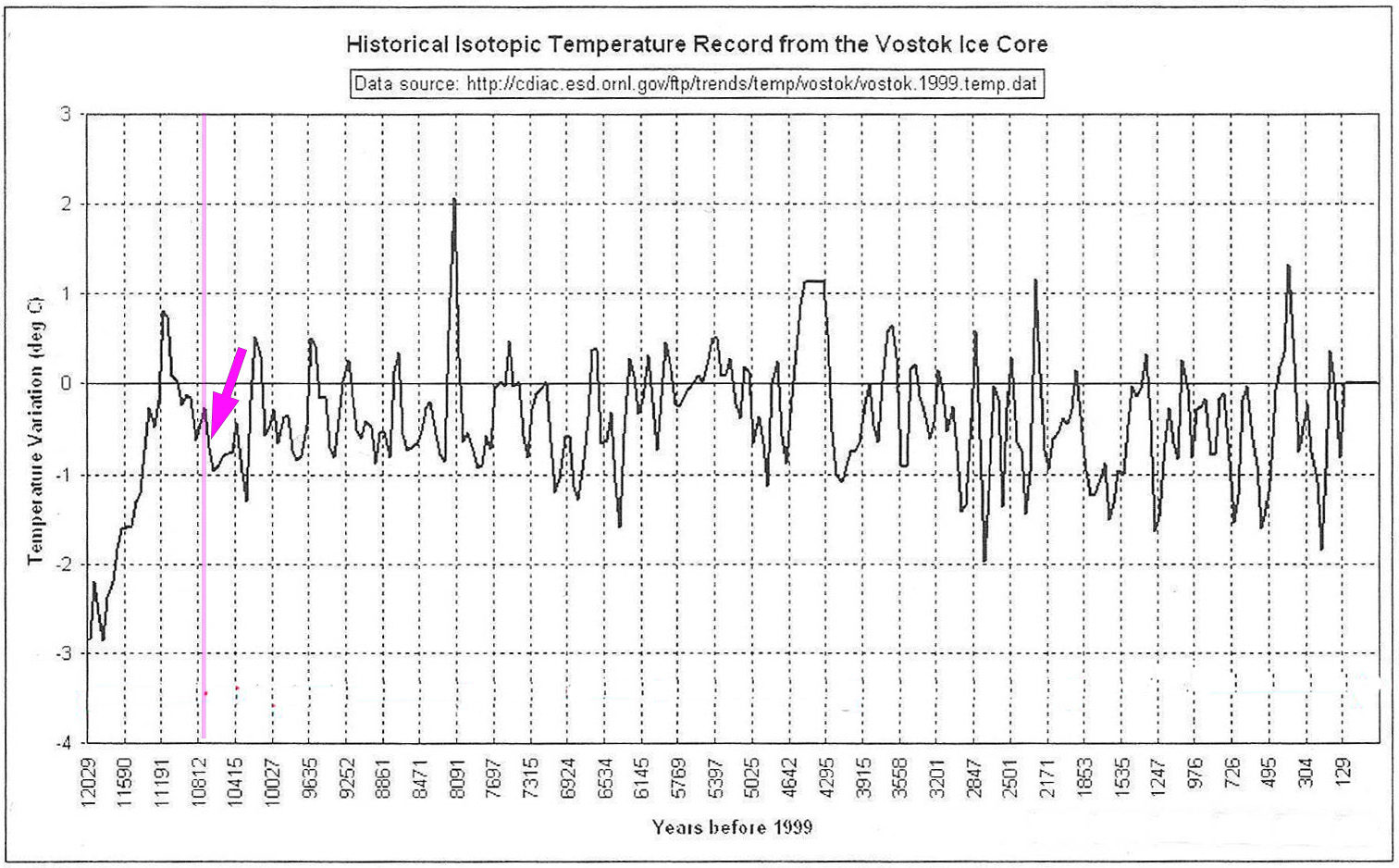
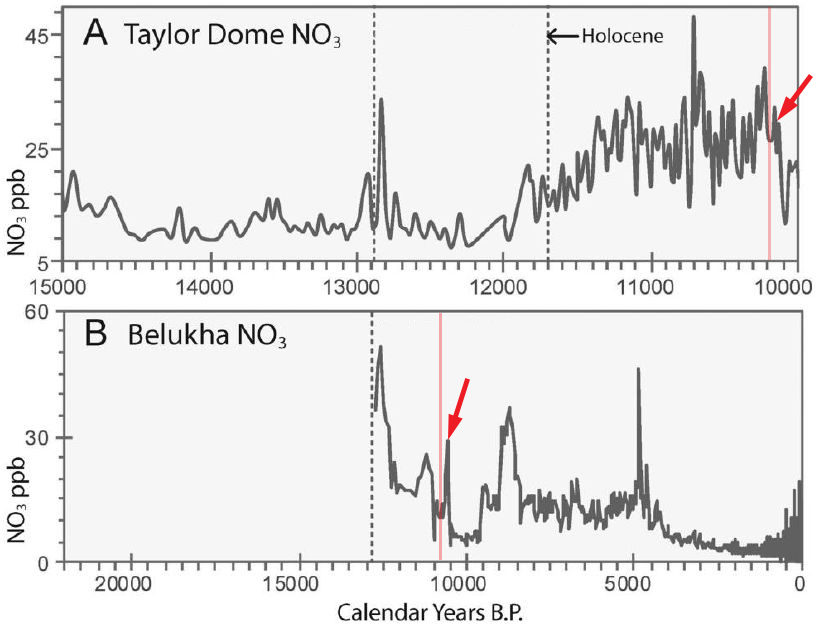



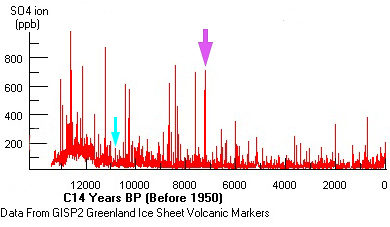
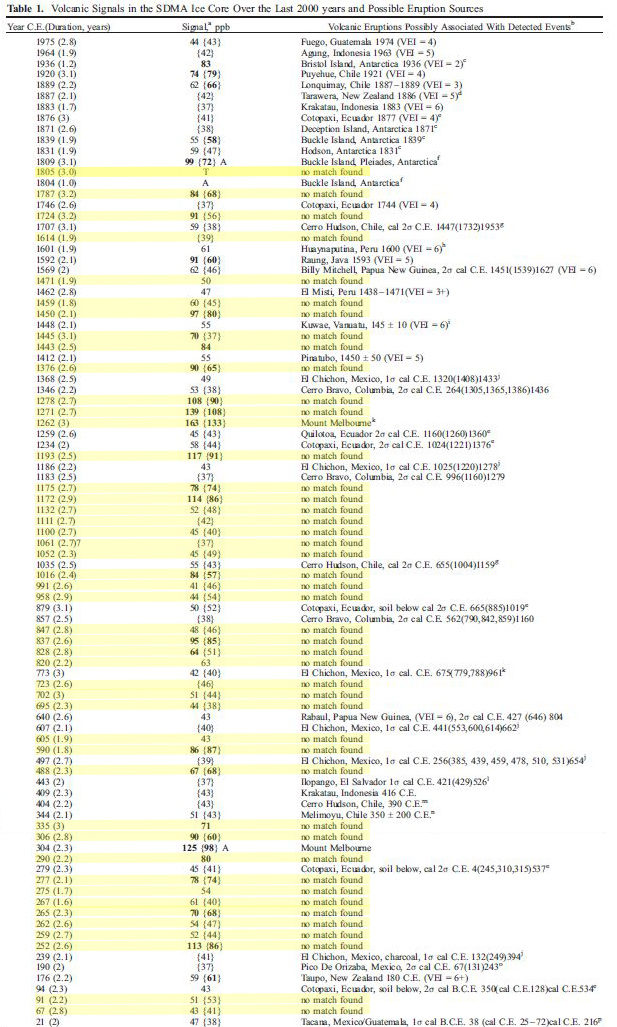


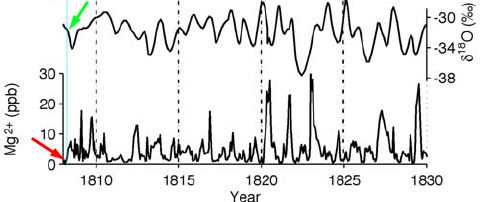

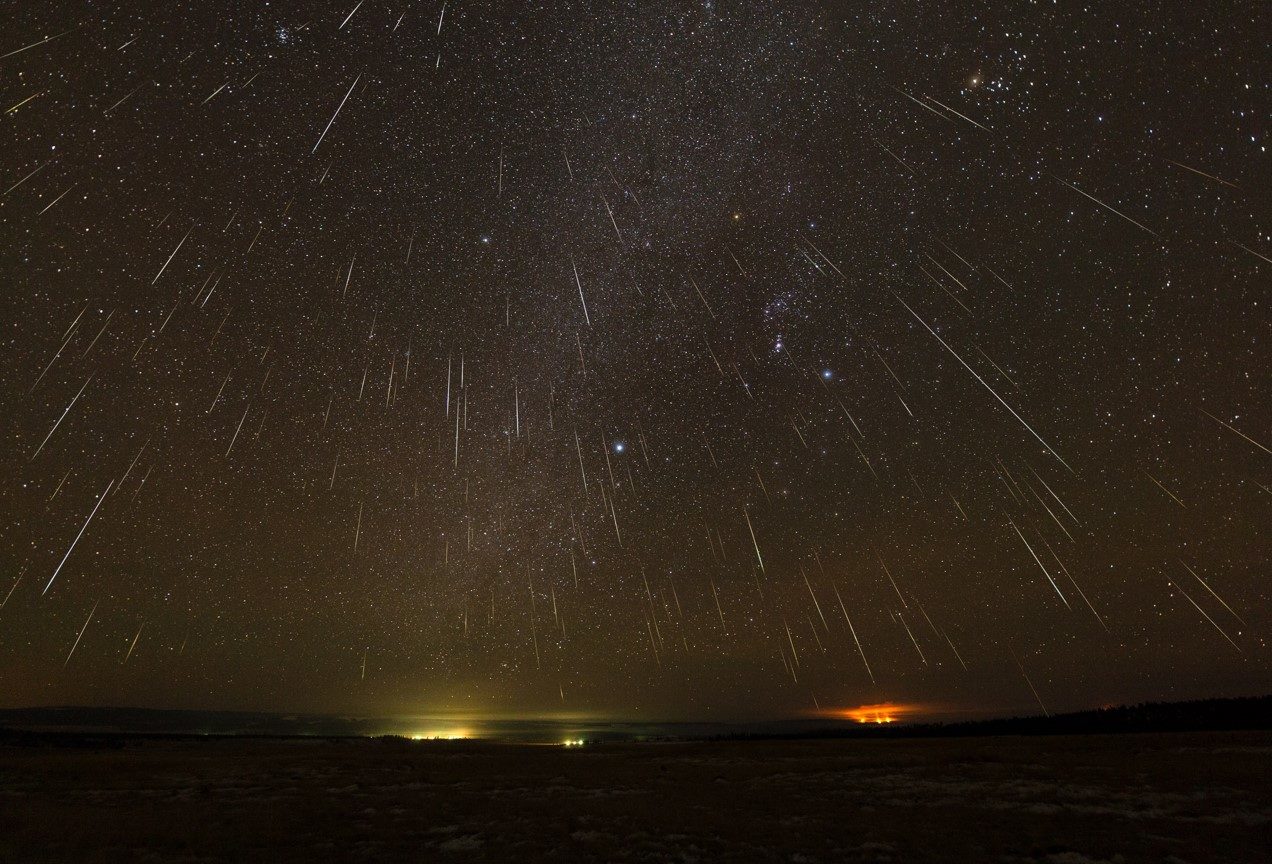
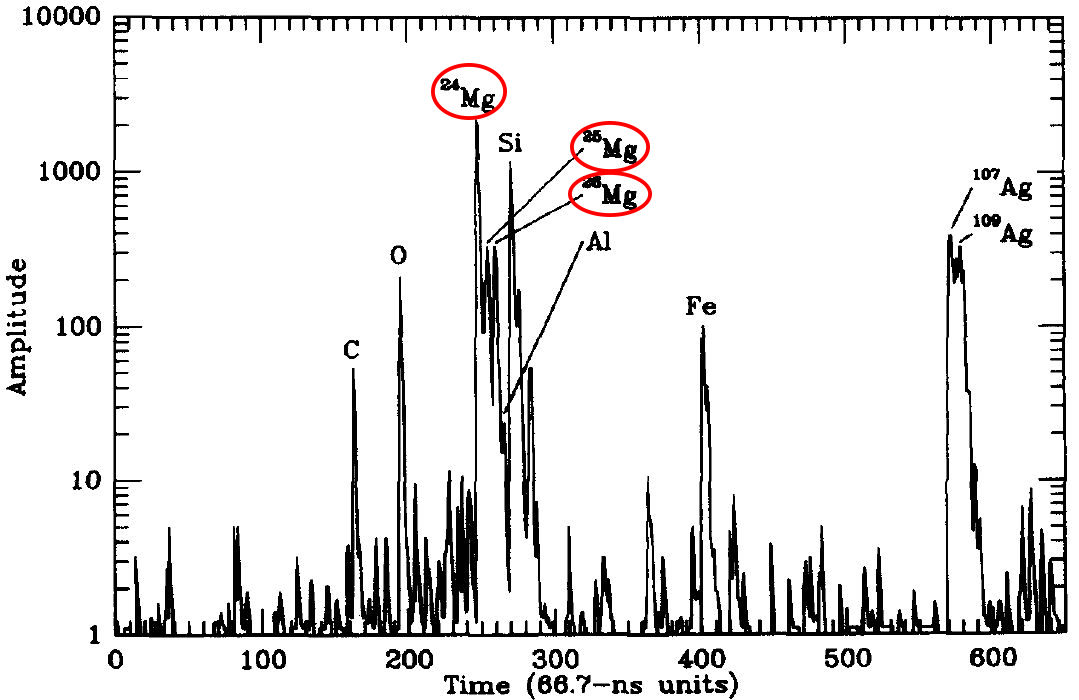


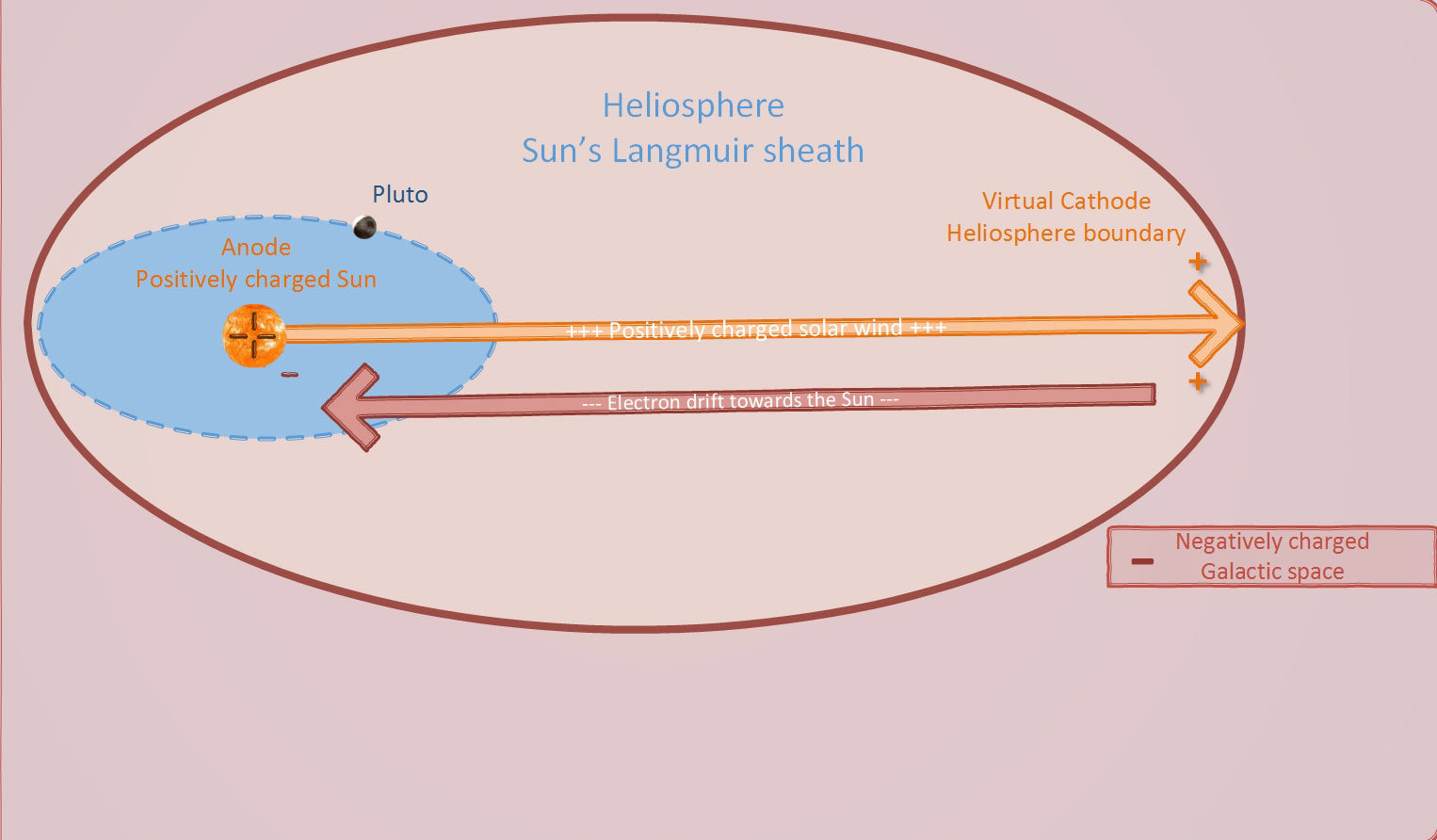

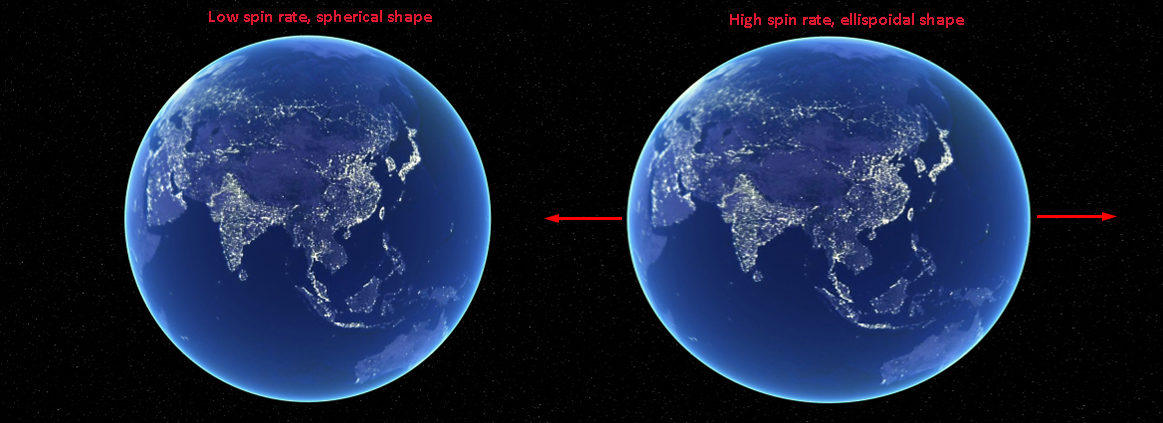
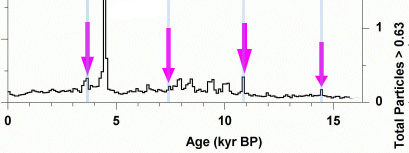





Læserkommentarer
dig vores Nyhedsbrev